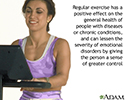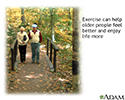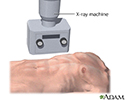Multimedia Gallery
Fibromyalgia
Usually when you're in pain, you can quickly find the cause, like the muscle you strained while working out, or the cut you gave yourself while slicing carrots. Yet for people with fibromyalgia, the source of their pain is harder to pinpoint. Although they experience pain daily, it can take some time to find the cause, and to get the right treatment for it.
Fibromyalgia is still somewhat of a mystery, because no one knows what causes it and it's often mistaken for conditions with similar symptoms, like Lyme disease or depression. Some people think fibromyalgia stems from physical or emotional trauma. Others believe it's caused by an abnormal response to pain.
Whatever the cause, fibromyalgia leads to widespread areas of pain on both sides of the body, and both below and above the waist. The pain may feel like an ache, or a sharp stabbing feeling, and it doesn't go away. To be diagnosed with fibromyalgia, you need to have physical findings at at least 11 specific tender points, which can be in your arms, buttocks, chest, knees, lower back, neck, rib cage, shoulders, or thighs. Doctors may diagnose fibromyalgia without a tender point examination by using the widespread pain index (WPI), and the symptoms severity scale score (SS). If the symptoms have been present at a similar level for at least 3 months and there is no other disorder that would otherwise explain the pain. The pain may get worse when you exercise, go outside in cold weather, or are under a lot of stress. In addition to pain, you may have problems concentrating or fatigue, and waking up unrefreshed. And you may have any of a long list of other symptoms as well including in the GI tract, urinary system, nervous system, and skin.
There's no cure for fibromyalgia, but there are treatments to control your symptoms. Your doctor will probably start you on an exercise regimen and have you work with a physical therapist. Some have found real help from acupuncture, learning Tai Chi, or taking yoga classes. You may also need to take medicine to help you sleep and relieve your pain. Medicines that are commonly prescribed for fibromyalgia include antidepressants, antiseizure medications, pain relievers, and sleep aids. Meanwhile, talking to a therapist can help you better manage and live with your pain, and deal with any negative thoughts you may have about your condition.
Despite improvements in the way doctors diagnose and treat fibromyalgia, it's still a chronic condition. But by working with your doctor, you can manage the symptoms and learn to live with them, so that you can control your fibromyalgia, rather than the other way around.
Fibromyalgia
Review Date: 1/28/2025
Reviewed By: Diane M. Horowitz, MD, Rheumatology and Internal Medicine, Northwell Health, Great Neck, NY. Review provided by VeriMed Healthcare Network. Also reviewed by David C. Dugdale, MD, Medical Director, Brenda Conaway, Editorial Director, and the A.D.A.M. Editorial team.
Animations
- Ankle ligament injury
- Ankylosing spondylitis
- Anterior shoulder stretch
- Arm reach
- Arthritis
- Bone fracture repair
- Bunion
- Carpal tunnel syndrome
- Exercise
- External rotation with band
- Fibromyalgia
- Foot pain
- Heel pain
- Herniated disk
- Herniated nucleus pulposus ...
- Hip joint replacement
- How to use a pill cutter
- Internal rotation with band
- Isometric
- Knee joint replacement
- Multiple sclerosis
- Neck pain
- Osteoarthritis
- Osteoarthritis
- Osteoporosis
- Osteoporosis
- Pendulum exercise
- Plantar fasciitis
- Rheumatoid arthritis
- Rotator cuff problems
- Sciatica
- Scoliosis
- Shoulder blade retraction
- Shoulder blade retraction w...
- Shoulder joint dislocation
- Shoulder pain
- Spinal stenosis
- Stretching back of your shoulder
- Up the back stretch
- Vacation health care
- Wall push-up
- Wall stretch
- What is tennis elbow?
Illustrations
- ACL degrees
- ACL injury
- Active vs. inactive muscle
- Aerobic exercise
- Ankle anatomy
- Ankle sprain
- Ankle sprain swelling
- Anterior cruciate ligament ...
- Anterior skeletal anatomy
- Arthritis in hip
- Aseptic necrosis
- Baker cyst
- Benefit of regular exercise
- Blood supply to bone
- Blood test
- Bone biopsy
- Bone density scan
- Bone graft harvest
- Bone tumor
- Bone-building exercise
- Bursa of the elbow
- Bursa of the knee
- Bursitis of the shoulder
- Calcium benefit
- Calcium source
- Calculating body frame size
- Calories and fat per serving
- Carpal biopsy
- Carpal tunnel surgical procedure
- Carpal tunnel syndrome
- Cauda equina
- Central nervous system
- Central nervous system and ...
- Cervical spondylosis
- Cervical vertebrae
- Changes in spine with age
- Chest stretch
- Chondromalacia of the patella
- Clubfoot deformity
- Colles fracture
- Common peroneal nerve dysfu...
- Compression fracture
- Compression of the median nerve
- Congenital hip dislocation
- Contracture deformity
- Corns and calluses
- CREST syndrome
- CT scan
- Damaged axillary nerve
- Dislocation of the hip
- Early treatment of injury
- Elbow - side view
- Electromyography
- Ewing sarcoma - x-ray
- Exercise - a powerful tool
- Exercise and age
- Exercise and heart rate
- Exercise can lower blood pr...
- Exercise with friends
- External fixation device
- Fast food
- Femoral fracture
- Femoral nerve damage
- Fibromyalgia
- Fish in diet
- Foot swelling
- Forward bend test
- Fracture types (1)
- Fracture types (2)
- Fracture, forearm - x-ray
- Fractures across a growth plate
- Groin stretch
- Hammer toe
- Hamstring stretch
- Head trauma
- Healthy diet
- Herniated disk repair
- Herniated lumbar disk
- Herniated nucleus pulposus
- Hip fracture
- Hip stretch
- Hunger center in brain
- Hypermobile joints
- Impingement syndrome
- Inflamed Achilles tendon
- Inflamed shoulder tendons
- Internal fixation devices
- Intervertebral disk
- Isometric exercise
- Joint aspiration
- Knee arthroscopy
- Knee joint
- Knee joint replacement pros...
- Knee pain
- Kyphosis
- Lateral collateral ligament
- Lateral collateral ligament...
- Lateral collateral ligament pain
- Leg pain (Osgood-Schlatter)
- Leg skeletal anatomy
- Limited range of motion
- Location of whiplash pain
- Lordosis
- Lower leg edema
- Lower leg muscles
- Lower leg muscles
- Lumbar vertebrae
- Lupus - discoid on a child'...
- Lupus - discoid on the face
- Lupus, discoid - view of l...
- Medial collateral ligament
- Medial collateral ligament ...
- Medial collateral ligament pain
- Meniscal tears
- Metatarsus adductus
- MRI scans
- Muscle biopsy
- Muscle cells vs. fat cells
- Muscle pain
- Muscle strain
- Muscular atrophy
- myPlate
- Neck pain
- Nerve biopsy
- Nerve conduction test
- Normal foot x-ray
- Normal knee anatomy
- Nuclear scan
- Osteoarthritis
- Osteoarthritis
- Osteoarthritis vs. rheumato...
- Osteogenic sarcoma - x-ray
- Osteomyelitis
- Osteoporosis
- Osteoporosis
- Patellar dislocation
- Physical activity - prevent...
- Plantar fascia
- Plantar fasciitis
- Posterior cruciate ligament...
- Posterior spinal anatomy
- Psoriasis - guttate on the ...
- Psoriasis - guttate on the cheek
- Radial head injury
- Radial nerve dysfunction
- Raynaud's phenomenon
- Reactive arthritis - view o...
- Retrocalcaneal bursitis
- Rheumatoid arthritis
- Rheumatoid arthritis
- Rheumatoid arthritis
- Rheumatoid arthritis
- Rotator cuff muscles
- Runners knee
- Sacrum
- Sciatic nerve
- Sciatic nerve damage
- Sclerodactyly
- Scoliosis
- Scoliosis
- Scoliosis brace
- Shin splints
- Shoulder arthroscopy
- Shoulder joint
- Shoulder joint inflammation
- Shoulder sling
- Signs of scoliosis
- Skeletal spine
- Skeleton
- Smashed fingers
- Spinal anatomy
- Spinal cord injury
- Spinal curves
- Spinal fusion
- Spinal stenosis
- Spinal stenosis
- Spinal tumor
- Spine supporting structures
- Sprained ankle
- Superficial anterior muscles
- Surface anatomy - normal palm
- Surface anatomy - normal wrist
- Synovial biopsy
- Synovial fluid
- Systemic lupus erythematosus
- Systemic lupus erythematosu...
- Tailbone (coccyx)
- Telangiectasia
- Tendinitis
- Tendon vs. ligament
- Tendonitis
- Tendons and muscles
- The structure of a joint
- Thigh stretch
- Tibial nerve
- Tophi gout in hand
- Torn lateral collateral ligament
- Torn medial collateral ligament
- Torticollis (wry neck)
- Treatment for leg strain
- Triangular shoulder sling
- Triceps stretch
- Ulnar nerve damage
- Uric acid crystals
- Vertebra, cervical (neck)
- Vertebra, lumbar (low back)
- Vertebra, thoracic (mid back)
- Vertebrae
- Vertebral column
- Vitamin D source
- Weight loss
- Whiplash
- Wrist anatomy
- Wrist splint
- X-ray
- X-ray
- Yo-yo dieting
Presentations
- Ankle sprain - Series
- Anterior cruciate ligament ...
- Bone fracture repair - series
- Bunion removal - series
- Carpal tunnel repair - series
- Clubfoot repair - series
- Creating a sling - series
- Hand splint - series
- Hip joint replacement - series
- Knee arthroscopy - series
- Knee joint replacement - series
- Leg lengthening - series
- Lumbar spinal surgery - series
- Microdiskectomy - series
- Partial knee replacement - ...
- Rotator cuff repair - series
- Shoulder separation - series
- Spinal bone graft - series
- Spinal fusion - series
- Spinal surgery - cervical -...
- Two person roll - series

 Bookmark
Bookmark


























































































































































































































































































